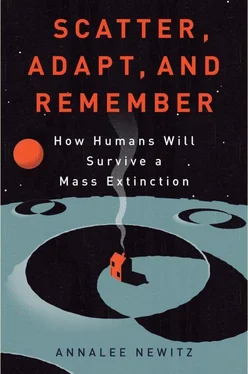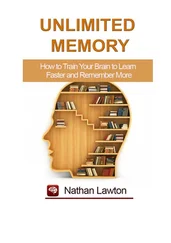Her vision isn’t just science fiction. Recently, Armstrong worked with a group of biologists and designers who hope to use experimental proto-cells—basically, a few chemicals wrapped in a membrane—in a project that could prevent Venice from sinking into the water. Proto-cells are semi-biological, and can be designed to carry out very simple chemical processes. In Venice, engineers would release proto-cells into the water. Designed to prefer darkness, the proto-cells would quickly head for the rotting pilings beneath the city’s dwellings. Once attached to the wood, the cells would slowly undergo a chemical transformation in which their flexible membranes transformed into calcium shells. These calcium shells would form the core of a new, artificial reef. As wildlife discovered the calcium deposits, a natural reef would form. Over time, the city’s shaky foundations would become a stable reef ecosystem. Already, Armstrong and her group have had some success creating small-scale versions of the proto-cell reef in the lab, and they’re moving on to experiments in controlled natural areas.
If our cities do evolve to be more like biological organisms and ecosystems, it could change the way communities form within their walls. “We might start to experience the city as something we have to take care of the way we take care of our bodies,” Armstrong suggested. In a biological city, using toxic chemicals in your kitchen might cause your algae lights to die. “We’ll take more care of the city because we feel its injuries more deeply,” Armstrong said. It’s possible that this would generate a sense of collective responsibility for our buildings and avenues. Neighbors would tend their buildings together, trading recipes for making fuel the way people today trade recipes for holiday cakes.
Armstrong’s hyper-technological biometropolis shares something in common with Judith Layzer’s vision of small, slow cities devoted to farming. Both of them arise from the belief that city dwellers will become producers rather than consumers. With home bioreactors, Armstrong said, “our spaces will become a place where we can generate wealth.” This idea is central to the SPIN model of urban farming, too. “It’s about decentralizing energy and food production, basically,” Armstrong concluded. Of course, it’s impossible to predict what the consequences would be for people in cities whose buildings were half-alive. Armstrong is willing to admit her ideas are utopian, and that’s the point. “You need something to aim at,” she said with a smile.
As we look further to the future in the next part, we’ll be taking aim at something even more speculative than self-healing cities that look like glowing ruins and sprout food and power from every surface. We’ll see what humanity might become if we manage to survive for another million years. To do this we’re going to need to do more than rebuild our cities. We’ll need to rebuild the entire Earth. And then we’ll start striking out for the territories beyond our planet, lifting ourselves into space and colonizing the solar system. What will humans be like after tens of thousands of years of evolution, especially in space? It’s possible that our progeny will be as unlike us as we are from Australopithecus —and yet they will still be as human as our distant hominin ancestors were.
PART V
THE MILLION-YEAR VIEW
THE LONG-TERM GOAL for Homo sapiens as a species right now should be to survive for at least another million years. It’s not much to ask. As we know, a few species have survived for billions of years, and many have survived for tens of millions. Our ancient ancestors started exploring the world beyond Africa over a million years ago, and so it seems fitting to pick the next million years as the first distant horizon where we’ll set our sights. We’ve already talked about how we can start this journey by building cities that are safer and more sustainable. Eventually, however, we’re going to build cities on the Moon and other planets. Our future is among the stars, as the science-fiction author Octavia Butler suggests. But long before we have the technologies to get there, our survival will depend on looking at Earth from the perspective of extraterrestrials.
Imagine we’re on an interstellar voyage and we encounter an Earthlike planet. As we survey it from orbit, we discover that this planet is full of life, and covered with sprawling artificial structures built by a scientifically advanced civilization. Seeing those, most of us would say the planet is controlled by a group of intelligent beings. That’s the extraterrestrial perspective. Right now, we’re stuck in the terrestrial perspective, where we do not really regard ourselves as “controlling” the Earth. Nor do we see ourselves as one group. From space we might look like a unified civilization of clever monkeys who hang out together building towers, but down on Earth we are Russians, Nigerians, Brazilians, and many other identities that divide us. Our differences aren’t always a problem. But they have so far prevented us from coming up with a global solution to maintaining the Earth’s resources. We won’t make it into the far future unless we start banding together as a species to control the Earth in a way we never have before.
When I say “control the Earth,” I don’t mean that we’ll all shake our fists at the sky and declare ourselves masters of everything. As entertaining as that would be, I’m talking about something a bit less grandiose. We simply need to take responsibility for something that’s been true for centuries: Human beings control what happens to most ecosystems on the planet. We’re an invasive species, and we’ve turned wild prairies into farms, deserts into cities, and oceans into shipping lanes studded with oil wells. There is also overwhelming evidence that our habit of burning fossil fuels has changed the molecular composition of the air we breathe, pushing us in the direction of a greenhouse planet. More than at any other time in history, humans control the environment. Still, our environment is going to change disastrously at some point, whether it’s heated by our carbon emissions from fossil fuels or cooled by megavolcano eruptions.
Our first priority in the near future must be to control our carbon output. I cannot emphasize this enough. As environmental writers like Bill McKibben and Mark Hertsgaard have argued, our fossil-fuel emissions are heating up the planet, and we can prevent this situation from becoming worse by using green sources of energy. Maggie Koerth-Baker points out in Before the Lights Go Out: Conquering the Energy Crisis Before It Conquers Us that we already have several types of sustainable energy to choose from, including solar and wind. Government representatives who attend the annual U.N. Climate Change Conferences are also coming up with strategies to encourage countries to curb fossil-fuel use, proposing everything from carbon taxes to emissions regulations.
The problem is that our climate has already been permanently changed for the next millennium, as the geobiologist Roger Summons explained in part one of this book. To prevent the planet from becoming uninhabitable, we’ll have to take our control of the environment a step further and become geoengineers, or people who use technology to shape geological processes. Though “geoengineering” is the proper term here, I used the word “terraforming” in the title of this chapter because it refers to making other planets more comfortable for humans. Earth has been many planets over its history. As geoengineers, we aren’t going to “heal” the Earth, or return it to a prehuman “state of nature.” That would mean submitting ourselves to the vicissitudes of the planet’s carbon cycles, which have already caused several mass extinctions. What we need to do is actually quite unnatural: we must prevent the Earth from going through its periodic transformation into a greenhouse that is inhospitable to humans and the food webs where we evolved. Put another way, we need to adapt the planet to suit humanity.
Читать дальше






![Аннали Ньюиц - Автономность [litres]](/books/424681/annali-nyuic-avtonomnost-litres-thumb.webp)





